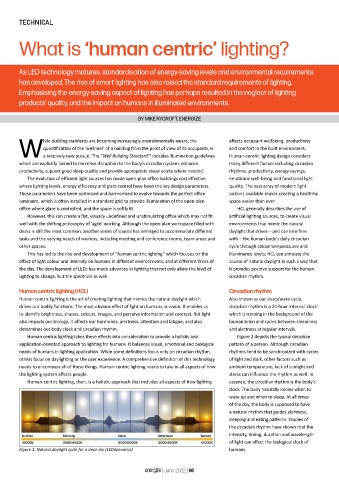Page 62 - Energize June 2022
P. 62
TECHNICAL
What is ‘human centric’ lighting?
As LED technology matures, standardisation of energy-saving levels and environmental requirements
has developed. The rise of smart lighting has also raised the standard requirements of lighting.
Emphasising the energy-saving aspect of lighting has perhaps resulted in the neglect of lighting
products’ quality, and the impact on humans in illuminated environments.
BY MIKE RYCROFT, ENERGIZE
hile building standards are becoming increasingly environmentally aware, the affects occupant wellbeing, productivity
quantification of the ‘wellness’ of a building from the point of view of its occupants, is and comfort in the built environment.
1
Wa relatively new pursuit. The “Well Building Standard” includes illumination guidelines Human-centric lighting design considers
which are explicitly ‘aimed to minimise disruption to the body’s circadian system, enhance many different factors including circadian
productivity, support good sleep quality and provide appropriate visual acuity where needed’. rhythms, productivity, energy savings,
The evolution of efficient light sources has made open-plan office buildings cost effective, emotional well-being and functional light
where lighting levels, energy efficiency and glare control have been the key design parameters. quality. The vast array of modern light
These parameters have been optimised and harmonised to evolve towards the perfect office options available makes creating a healthful
luminaire, which is often installed in a standard grid to provide illumination of the open-plan space easier than ever.
office where glare is controlled, and the space is softly lit. HCL generally describes the use of
However, this can create a flat, visually undefined and unstimulating office which may not fit artificial lighting sources, to create visual
well with the shifting philosophy of ‘agile’ working. Although the open-plan workspace filled with environments that mimic the natural
desks is still the most common, another series of spaces has emerged to accommodate different daylight that drives – and can interfere
tasks and the varying needs of workers, including meeting and conference rooms, team areas and with – the human body’s daily circadian
other spaces. cycle through colour temperatures and
This has led to the rise and development of “human centric lighting” which focuses on the illuminance levels; HCL can simulate the
effect of light colour and intensity on humans in different environments, and at different times of course of natural daylight in such a way that
the day. The development of LEDs has made advances in lighting that not only allow the level of it provides positive support for the human
lighting to change, but the spectrum as well. circadian rhythm.
Human centric lighting (HCL) Circadian rhythm
Human centric lighting is the art of creating lighting that mimics the natural daylight which Also known as our sleep/wake cycle,
drives our bodily functions. The most obvious effect of light on humans, is vision. It enables us circadian rhythm is a 24-hour internal ‘clock’
to identify brightness, shapes, colours, images, and perceive information and contrast. But light which is running in the background of the
also impacts our biology; it affects our hormones, alertness, attention and fatigue, and also human brain and cycles between sleepiness
determines our body clock and circadian rhythm. and alertness at regular intervals.
Human centric lighting takes these effects into consideration to provide a holistic and Figure 2 depicts the typical circadian
application-oriented approach to lighting for humans. It balances visual, emotional and biological pattern of a person. Although circadian
needs of humans in lighting application. While some definitions focus only on circadian rhythm, rhythms tend to be synchronized with cycles
others focus on daylighting or the user experience. A comprehensive definition of this technology of light and dark, other factors such as
needs to encompass all of these things. Human-centric lighting needs to take in all aspects of how ambient temperature, lack of sunlight and
the lighting system affects people. stress can influence the rhythm as well. In
Human-centric lighting, then, is a holistic approach that includes all aspects of how lighting essence, the circadian rhythm is the body’s
clock. The body naturally knows when to
wake up and when to sleep. At all times
of the day, the body is supposed to have
a natural rhythm that guides alertness,
sleeping and eating patterns. Studies of
the circadian rhythm have shown that the
intensity, timing, duration and wavelength
of light can affect the biological clock of
Figure 1: Natural daylight cycle for a clear sky (LEDdynamics) humans.
energize | June 2022 | 60

